- "Marvolo, his son, Morfin, and his daughter, Merope, were the last of the Gaunts, a very ancient wizarding family noted for a vein of instability and violence that flourished through the generations due to their habit of marrying their own cousins."
- — Description of the Gaunts[src]
The House of Gaunt was a pure-blood family descended from Cadmus Peverell and Salazar Slytherin, and one of the Sacred Twenty-Eight. They had a tendency of marrying their cousins to keep their blood pure and to retain the traits of their ancestor, most notably the ability to speak Parseltongue.
The Gaunts lived just outside of Little Hangleton, a small village in northern England. They were very wealthy and prominent once, having descended from many powerful witches and wizards. But their liking for grandeur in tandem with little sensibility when it came to indulgences meant the family gold was squandered long before the last of the lineage was born.
History
Early history
- "Lack of sense coupled with a great liking for grandeur meant that the family gold was squandered... left in squalor and poverty..."
- — Mindset of the Gaunt family[src]
The House of Gaunt was once a prominent, wealthy family in the wizarding world, and originated from many powerfully magical wizards and witches.

Isolt is kidnapped by Gormlaith Gaunt after the latter burns down her parents' cottage
In the 1600s, Gormlaith Gaunt slew her sister Rionach and her husband William Sayre, for betraying the family's belief in Pure-blood supremacy and lending aid to neighbouring muggles. Gormlaith took their child, her niece Isolt Sayre. She imprisoned Isolt for twelve years, hoping to raise her in the family pure-blood traditions. Isolt ultimately fled to the new world and helped found Ilvermorny School of Witchcraft and Wizardry with her muggle husband James Steward.[1]

Gormlaith arrives at Ilvermorny to exact her revenge against Isolt and her family
Around 1634, Gormlaith found out a headteacher at a new school of magic in the New World was nicknamed "Morrigan". She remembered her niece was named this by her father because of their lineage to Morrigan herself. When she also heard the school was named Ilvermorny, she knew it was Isolt because it was the name of the same cottage Isolt was born in and Gormlaith set fire to. She was also upset to hear Isolt had married a Muggle and opened the school up to anyone with magic and not a select few of pure-bloods. She concocted a plan and set out to the New World in order to exact revenge on her niece. Her plans were going well. She had managed to back the Steward family into room and was preparing to murder James and the couple's daughters, when Isolt screamed the name William. A friend of Isolt's, a pukwudgie (by the name of William), appeared behind Gormlaith and shot her through the heart with an arrow, killing her instantly.

The Gaunts, being direct descendants of Salazar Slytherin also knew about the Chamber of Secrets, and Corvinus Gaunt was instrumental in keeping the entrance to the Chamber a secret. In the 1700s, there was a proposal to install an elaborate plumbing system at Hogwarts Castle. This, of course, threatened the secrecy around the entrance to the Chamber of Secrets, which, at the time, still had its original appearance — a concealed trapdoor and a series of magical tunnels — and which was located on the site where a girls' bathroom would be set up.
Corvinus Gaunt was, at the time, a student at Hogwarts and knew where the entrance to the Chamber was and how to open it. Corvinus was responsible for secretly protecting the entrance, having concealed it behind plumbing fixtures and a sink (which today are part of Moaning Myrtle's Bathroom), so that those who knew how could still access the Chamber.
Family traits
Up until the 20th century, every single member of the Gaunt family was Pure-blood. They were also the last known descendants of Salazar Slytherin, as well as descendants of the Peverells, famed ancestors in whom they took great pride.
As stated above, the Gaunts inherited their ancestor's ability to speak Parseltongue. Like other Pure-blood families of the time, they were supreme advocates of blood purity and were often inbred in order to maintain "purity." However, by the twentieth century, mentally unstable members of the family had squandered the family's fortune and cost it much of its prestige among elite Pure-blood circles. Despite this, their habit of keeping themselves pure allowed them to become one of the Sacred Twenty-Eight.
20th century
The Gaunt shack seen through Bob Ogden's memory
By the early twentieth century, the Gaunts had been reduced to poverty, possessing only a few old heirlooms and living in a small, run-down shack. Additionally, generations of inbreeding had made them violent and unstable. Marvolo Gaunt was abusive toward his daughter Merope, whose emotional trauma made it difficult for her to use magic, making others believe she was a Squib. Her brother Morfin spoke in Parseltongue more than English and frequently terrorised Muggles, eventually leading to his imprisonment in Azkaban.
Merope went against her family's beliefs and married the muggle Tom Riddle Snr via coercion. She gave birth to their only child, who would become the notorious Dark Wizard, Lord Voldemort. Marvolo, returning from a six-month term in Azkaban, died due to either shock at Merope's betrayal or never learning to feed himself, never again mentioning his daughter's existence. Morfin, returning from his three-year sentence, then succeeded as the patriarch of the family.[2]
Morfin lived, as the last male heir to the Gaunt name, in solitude for the next thirteen years, with very poor care of his hygiene and household, leaving his appearance and the shack to deteriorate drastically. He was sentenced to life in Azkaban when his nephew, Voldemort, came to visit to learn about his heritage, who then used Morfin as a scapegoat for the murder of the Riddle family. With an implanted memory, Morfin easily confessed to a crime he did not commit, and was incarcerated until his death.

Tom Riddle, the alleged last of the Gaunt line, falls at the hands of Harry Potter
Upon the death of Morfin Gaunt, heir to the House of Gaunt, the male line of the Gaunt family ended. The female line, along with the Slytherin family and Riddle family, continued under Tom Marvolo Riddle, who would later be known as Voldemort. Although to the wizarding world at large that these three families ended with the death of Voldemort, in truth they continue with his secret daughter, Delphini, whom he sired with Bellatrix Lestrange. Delphini has been entombed in Azkaban for her crimes of murder and attempting to illegally alter timelines.
Family tree
| Peverell family | Slytherin family | Morrigan | |||||||||||||||||||||||||||||||||||||||||||||||||||
| Cadmus Peverell (fl. 1214) | Salazar Slytherin (fl. 993) | ||||||||||||||||||||||||||||||||||||||||||||||||||||
| (many generations) | |||||||||||||||||||||||||||||||||||||||||||||||||||||
| House of Gaunt | |||||||||||||||||||||||||||||||||||||||||||||||||||||
| (many generations) | Sayre family | Steward family | |||||||||||||||||||||||||||||||||||||||||||||||||||
| Corvinus Gaunt (fl. 1700s) | Gormlaith Gaunt (d. c. 1634) | Rionach Gaunt (d. 1608) | William Sayre (d. 1608) | Martha Steward (d. c. 1632) | |||||||||||||||||||||||||||||||||||||||||||||||||
| (many generations) | |||||||||||||||||||||||||||||||||||||||||||||||||||||
| Noctua Gaunt (d. c. 1890) | Mr Gaunt (fl. 1890s) | Mrs Gaunt (fl. 1890s) | Isolt Sayre (c. 1603—c.1703) | James Steward (c. 1603—c.1703) | |||||||||||||||||||||||||||||||||||||||||||||||||
| Riddle family | Children (fl. 1890s) | Ominis Gaunt (b. 1874/1875) | Chadwick Boot (b. c. 1618) | Webster Boot (b. c. 1620) | Martha Steward (b. c. 1634) | Rionach Steward (b. c. 1634) | |||||||||||||||||||||||||||||||||||||||||||||||
| (unclear relationship) | Calderon-Boot family | Boot family | |||||||||||||||||||||||||||||||||||||||||||||||||||
| Thomas Riddle (1880—1943) | Mary Riddle (1883—1943) | Marvolo Gaunt (d. late 1920s) | |||||||||||||||||||||||||||||||||||||||||||||||||||
| Tom Riddle (1905—1943) | Merope Gaunt (c.1907—1926) | Morfin Gaunt (fl.1925—fl.1943) | |||||||||||||||||||||||||||||||||||||||||||||||||||
| House of Black | Lestrange family | ||||||||||||||||||||||||||||||||||||||||||||||||||||
| Tom M. Riddle (1926—1998) | Bellatrix Black (1951—1998) | Rodolphus Lestrange (b. c. 1953) | |||||||||||||||||||||||||||||||||||||||||||||||||||
| Delphini (b. c. 1998) | |||||||||||||||||||||||||||||||||||||||||||||||||||||
Heirlooms
Once a very wealthy family, the Gaunt family had squandered much of their gold early due to the Gaunt family's love for grandeur and mental instability, leaving them with very little inheritances for the later generations.
Gormlaith Gaunt possessed Salazar Slytherin's wand and used it to torture muggles and entrap her niece Isolt Sayre. Isolt stole the wand when she fled to the New World in 1620. It was deactivated by a spell from Gormlaith when she hunted down her niece around 1634 and was eventually buried at Ilvermorny School of Witchcraft and Wizardry where it grew into a unique snakewood tree whose leaves had magical properties.
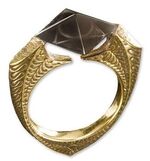
Marvolo Gaunt was in possession of a signet ring passed on from his Peverell ancestors. This ring was eventually turned into a Horcrux by Voldemort and destroyed by Dumbledore with the Sword of Gryffindor. It also contained the Resurrection Stone, one of the legendary Deathly Hallows, something Voldemort had no knowledge of. The Stone itself was lost in the Forbidden Forest when Harry Potter dropped it as he went to confront Voldemort.
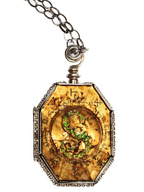
The Gaunts also held onto Salazar Slytherin's locket for many generations. However, Merope later sold it to Borgin and Burkes in order to support herself while she was pregnant. It later came into the possession of Hepzibah Smith, whom a teenage Tom Marvolo Riddle killed and stole the locket from (or, in Riddle's opinion, retrieved what was rightfully his). He also turned this heirloom of his mother's family into a Horcrux.[2] Much later, it was stolen from its hiding place by Regulus Black and later destroyed by Ron Weasley with the Sword of Gryffindor.[3]
Etymology
The word gaunt is defined as "haggard, drawn and emaciated" and "bleak, desolate."[4]
John of Gaunt was a fourteenth-century English noble. Gaunt, in his case, was a phonetic corruption of his birthplace, the city that would become Ghent, Belgium.
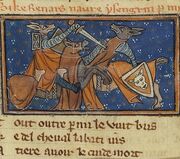
Fox (left) versus wolf (right), in a miniature (Bibliothèque nationale de France, Paris, MS fr. 1581f. 6v) from Renart le Nouvel by Giélée (1290/1300 A.D.)
Earlier designations "of Ghent" had been seen as early as 1148-1149 A.D., with the Flemish author and poet Nivardus of Ghent / "Gaunt" (also known as "Baldwin / Bernard the Blind"), who is largely attributed as the writer of "the first great beast epic poem" and "one of the most cynical, mocking, and grim satires ever written", Ysengrimus. Its chief character is Isengrin ("Ysengrimus") the Wolf, and it describes how his various schemes are overcome by the cunning, deceptive trickster figure Reynard ("Reinardus") the Fox. Nivardus's work became so popular that the word renard became the French word for "fox".
Ysengrimus, as penned by Nivardus, is usually held to be an allegory for the corrupt monks of the Roman Catholic Church. Ysengrimus's greed is what typically causes him to be led astray, and he comes to a grisly end in the ending of the poem. Reinardus the Trickster, by contrast, represents the poor and the lowly; he triumphs over the "greedy and corrupt" Ysengrimus by his wits, and glorifies the power and value of cunning and ambition. GauntFamily.jpeg
John of Gaunt was a son of King Edward III of England, but as he was only the third son, he and his descendants were not expected to ascend to the throne, which they ultimately did. First, through his legitimate male descendants the Lancasters, and then through his debatably illegitimate descendants, by his long time mistress and then third wife Katherine Swynford, the Beauforts. Henry Tudor (later Henry VII)'s mother was a Beaufort, and his claim to the throne derived from her. Therefore, John of Gaunt is an ancestor of the House of Tudor.
Gaunt's heir deposed a king and usurped the throne, possibly alluding to the Gaunts' descendant Voldemort's attempts to overthrow wizarding Britain's government and rule it himself. Also, Gaunt's great-grandson, Henry VI, was notorious for his mental instability, which was earlier pointed out as a characteristic of the House of Gaunt, but in Henry VI's case it probably derived from his grandfather, Charles VI of France.
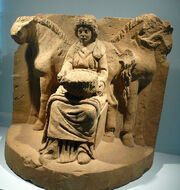
Epona and her horses, from Köngen, Germany, about 200 AD.
Gaunt may also derive from an ancient Celtic goddess, Gontia ("Guntia" in Latin), whose name, according to some historians, was adopted for the city of Ghent, said to be "her patron village". "Gontia" is also thought to relate to the Welsh word canda ("shining white"), from depictions of her riding a white horse, and the Celtic condate ("confluence").
Gontia was the patron goddess of horses; the moon; rivers / water; fate or destiny; and luck / fortune. Offerings were made to her in order to ensure success, and "good luck", for favourable outcomes.
In Harry Potter and the Half-Blood Prince', in Bob Ogden's memory, Merope Gaunt is shown as pining for Tom Riddle Senior, who rides his horse, sometimes alongside Cecilia, past the Gaunt Shack every day.

Ginny Weasley's corporeal horse Patronus
Likewise, Ginny Weasley, who is possessed by Gaunt descendant Tom Marvolo Riddle (Lord Voldemort) in Harry Potter and the Chamber of Secrets, has a Patronus of a "silvery-white" horse, and her wand is of the same wood, yew, as Tom Riddle's wand. Yew is also known for its "white" colouring, and Riddle's original wand is cited as "bone-white" in colour.
Etymology-wise, Gaunt may once have meant, "of Gontia". The goddess was the tutelary deity of the river Günz, near Günzburg in Germany. She is known from an inscription on a Roman-era altar at Günzburg, where a visiting Roman centurion wrote of making an offering to Gontia.
Gontia was also thought to have been equated with the goddesses Candida (Germany, "Candida the Queen" - Deae Candidae Reginae in Latin), Fortuna (Roman), Epona (Gaulish / French, designated as Epona Regina - "Queen Epona"), and Rhiannon (Anglo-Welsh, from Brittanic Rigantona, from rigan, "the Queen"). She is also known in the modern day as "Lady Fortune" or "Lady Luck", and associated with divination, magic, enchantment, astrology, and Prophecy.
Some accounts of her as Epona also depict her as "the leader of the soul to the afterlife"; the yew was also associated with death, rebirth, and "life beyond death". Likewise, yew was seen as appropriate for decorating for Yule, as the winter solstice represents the cusp between the season of life and the season of death. Most notably, Gaunt descendant Tom Marvolo Riddle (Lord Voldemort) was born on "the last day of the year", in winter - December 31 - signifying "the cusp between the dying old year, and the birth of the new year".
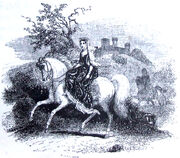
Rhiannon riding in Arberth. From The Mabinogion, translated by Lady Charlotte Guest, 1877
As Rhiannon, she first appears in a medieval Welsh story collection. She is a strong-minded "Otherworld" (magical) woman, who chooses Pwyll, prince of Dyfed (west Wales), as her consort, in preference to another man to whom she has already been betrothed. She is depicted as beautiful, intelligent, politically strategic, cunning, ambitious, and famed for her wealth and generosity. With Pwyll, she has a son, the hero Pryderi, who later inherits the lordship / throne of Dyfed.
As a widow after Pwyell's death, she remarries Manawydan of the British royal family, son of the Welsh god Llŷr, and has further adventures involving enchantments with him. Manawydan - also associated with magic and spells - has been depicted in lore as both a Knight of the Round Table in the court of King Arthur, and linked to the sorcerers Merlin and Morgan le Fay. He also served as an advisor to, and ambassador for, Brân the Blessed, another "King of Briton". Brân was also said to be Manawydan's older brother, and Llŷr's firstborn.
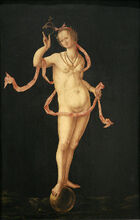
Fortuna lightly balances the orb of sovereignty between thumb and finger in a Dutch painting, ca 1530 A.D. (Musée des Beaux-Arts de Strasbourg)
As linked to Fortuna, the Roman goddess of fate and luck, she was also reputed to be "fickle", "two-faced", and linked to chaos and instability, as well as good fortune for those she favoured. Medieval representations of "Fortune" emphasise her duality, transience, and instability, such as two faces side by side; one face smiling, and the other frowning; half the face white, the other black. She may be blindfolded, but without scales, blind to justice.
"Lady Fortune" appears in chapter 25 of Machiavelli's The Prince, in which he says Fortune "only rules one half of men's fate, the other half being of their own will". Machiavelli reminds the reader that Fortune is a woman, and that "she favours a strong, or even violent hand, and that she favours the more aggressive and bold young man than a timid elder". This, too, seems to mirror the rise of the Gaunt descendant Tom Marvolo Riddle, or Lord Voldemort, as a "bold young man", even in spite of the efforts of Albus Dumbledore, a "timid elder"...and the Prophecy involving Harry Potter and Lord Voldemort.
Even William Shakespeare, whose work heavily inspired J. K. Rowling's writing of Harry Potter, was no stranger to "Lady Fortune", notably lamenting his "disgrace with Lady Fortune" in Sonnet 29.
In mythological lore, she claimed the life of Lucius, a prospective heir to the Roman empire, and was linked to virtue, or virtus (morals / strength of character). It was believed that those with ill-morals, or "lacking virtue", displeased the goddess, and invited "bad fortune" upon themselves. Lucius Malfoy, one of Lord Voldemort's followers and Death Eaters, seems to take his name from the Roman figure; and, he, too, "suffered Voldemort's wrath".
Behind the scenes
- The Gaunt family was largely omitted from the film adaptation of Harry Potter and the Half-Blood Prince. Dumbledore only makes reference to the Horcrux ring as having belonged to Voldemort's mother.
- According to Voldemort's diary, he and Harry Potter are the only two Parselmouths to enter Hogwarts since Salazar Slytherin himself.[5] This implies that the Gaunt family members (all of whom were Parselmouths) never attended Hogwarts, despite obtaining wands and knowing how to cast spells. However, Corvinus Gaunt, Voldemort's maternal ancestor and a presumed Parselmouth attended Hogwarts and protected the concealed entrance to the Chamber of Secrets during the installation of a plumbing system. Gormlaith Gaunt, also a Parselmouth, attended Hogwarts, which is revealed by J.K Rowling on Pottermore. Given that Tom Riddle struggled to find information on his parents and came upon his relation to Marvolo Gaunt perchance his study of old Wizarding families, it seems likely he would have been unaware of any of his maternal ancestors being fellow Hogwarts alumni.


